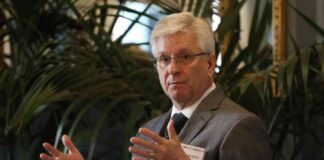Federal Reserve’s Bostic Open to September Rate Cut as Inflation Cools
In a recent development, Federal Reserve Bank of Atlanta President Raphael Bostic has signaled openness to a potential rate cut in September as a response to cooling inflation. This announcement comes amidst ongoing economic uncertainties and concerns about the impact of trade tensions on the global economy. Bostic’s remarks have sparked discussions among investors and policymakers about the future direction of monetary policy in the United States.
Market Reaction to Bostic’s Comments
Following Bostic’s statement, financial markets have reacted with a mix of anticipation and caution. The possibility of a rate cut in September has led to a weakening of the US dollar against major currencies, as investors adjust their expectations for future interest rates. Stock markets have also shown signs of volatility, with some analysts attributing the fluctuations to uncertainty surrounding the Fed’s next move.
While Bostic’s comments have been seen as a potential signal of dovishness within the Federal Reserve, some experts caution against reading too much into a single statement. The Fed’s decision-making process is complex and involves multiple factors beyond just inflation data. Therefore, market participants are advised to exercise caution and not make hasty decisions based solely on one policymaker’s remarks.
Factors Influencing the Fed’s Decision
The Federal Reserve’s monetary policy decisions are guided by a dual mandate of promoting maximum employment and stable prices. Inflation plays a crucial role in this framework, as the central bank aims to maintain price stability while supporting economic growth. However, the recent trend of cooling inflation has raised concerns about the effectiveness of the Fed’s current policy stance.
Several factors are contributing to the downward pressure on inflation, including slower global growth, subdued wage growth, and uncertainty stemming from trade tensions. These developments have led some Fed officials, including Bostic, to consider the possibility of easing monetary policy to stimulate economic activity and prevent inflation from falling below target levels.
Implications for the Economy
The potential for a rate cut in September could have significant implications for the broader economy. Lower interest rates typically lead to increased borrowing and spending, which can stimulate economic growth and support job creation. However, there are also risks associated with a more accommodative monetary policy, including the potential for asset bubbles and inflationary pressures in the long run.
Businesses and consumers alike will need to adapt to the changing interest rate environment and assess the impact on their financial decisions. For example, companies may reconsider their investment plans in response to lower borrowing costs, while individuals could adjust their savings and spending patterns based on changes in interest rates. Overall, the Fed’s policy decisions will have far-reaching consequences for the economy as a whole.
In conclusion, Federal Reserve Bank of Atlanta President Raphael Bostic’s openness to a potential rate cut in September reflects the central bank’s ongoing efforts to navigate a challenging economic environment. While the prospect of lower interest rates may provide support for growth and inflation, it also raises questions about the effectiveness of monetary policy in the current context. As investors and policymakers await further guidance from the Fed, it is essential to monitor developments closely and consider the potential implications for the economy and financial markets.

















